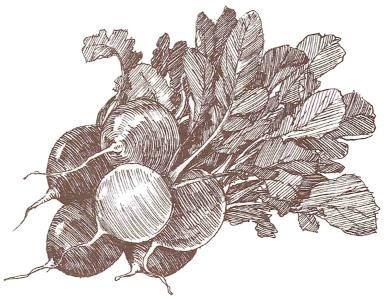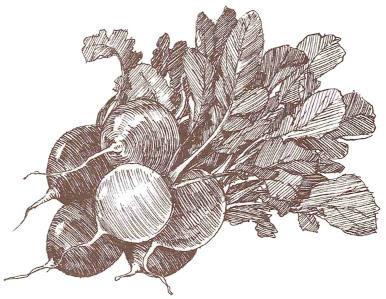Radishes are among the very first vegetables ready for harvest in the spring. They're also the best all-around companion plants. Here's how radishes work for you in the garden.
among the very first vegetables ready for harvest in the spring. They're also the best all-around companion plants. Here's how radishes work for you in the garden.
Early radishes germinate in three to seven days, marking your garden rows. This allows you to cultivate early with confidence when you interplant radishes with other slower-growing vegetables.
Multi-Use RadishesRadishes act as natural cultivators because their thick, round roots leave holes in the soil when harvested. These cavities provide "breathing space," so the remaining root crops can easily expand, moving the soil around them right into the cavities. Long, white icicle radishes are ideal for this, especially if you have heavy clay soil or if you want to grow long carrots or parsnips. Let the radishes grow beyond the eating stage -- until they're huge -- and then pull them. The remaining plants will expand and thrive in the newly created spaces.
Radishes are also trap crops for some garden insects. If there are hungry root maggots, leafhoppers or flea beetles around, they'll usually go for the first plants they find, and radishes are one of the earliest crops. You may even find them doing double duty with both their tops and bottoms acting as hosts for insects. Just pull and destroy the half-eaten radishes and you'll destroy the insects, too.
Radishes are great planted by themselves, but interplanting them with other crops is more space efficient, and will still provide you with plenty for fresh eating. Try growing them with lettuce or late-maturing crops such as cucumbers or squash.
Speaking of eating, the best-tasting radishes are small, about the diameter of a penny. Whether or not you plant radishes as a companion, harvest them for eating before they're fully mature. Even if the radish greens look chewed, the roots may still be okay to eat, so don't be fooled by their appearance.
Varieties
 Victory Seed Company has all the seeds you want for your best garden in 2024.
Victory Seed Company has all the seeds you want for your best garden in 2024.
For 25 years, the family-owned Victory Seed Company has provided the highest quality vegetable, herb and flower seeds to families across the country. We are passionate about providing you the best seeds available that give excellent germination, robust plants, and the harvest you want. With a catalog of over a thousand varieties, we have everything, and our prices are the kinds that we'd want to pay. We have hundreds of yesterday's heirloom vegetables, as well as today's award winning hybrid selections. Get to know us by visiting our website and browsing through our online vegetable seed catalog.
| 1. History of Root Crops |
| 2. All About Horseradish |
| 3. Beet Varieties |
| 4. Carrot Varieties |
| 5. Radish Varieties ← you're on this article right now |
| 6. Turnip and Rutabaga Varieties |
| 7. Celeriac - Lazy Man's Celery |
| 8. Parsnip Varieties |
| 9. All About Salsify |
| 10. Selecting Root Crop Seeds |
| 11. Planning Your Root Crop Garden |
| 12. How Root Crops Grow |
| 13. Carrot Essentials |
| 14. Parsnip Essentials |
| 15. Radish Essentials |
| 16. Turnip Essentials |
| 1. History of Root Crops |
| 2. All About Horseradish |
| 3. Beet Varieties |
| 4. Carrot Varieties |
| 5. Radish Varieties ← you're on this article right now |
| 6. Turnip and Rutabaga Varieties |
| 7. Celeriac - Lazy Man's Celery |
| 8. Parsnip Varieties |
| 9. All About Salsify |
| 10. Selecting Root Crop Seeds |
| 11. Planning Your Root Crop Garden |
| 12. How Root Crops Grow |
| 13. Carrot Essentials |
| 14. Parsnip Essentials |
| 15. Radish Essentials |
| 16. Turnip Essentials |